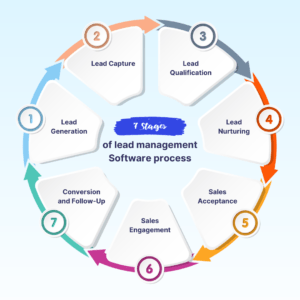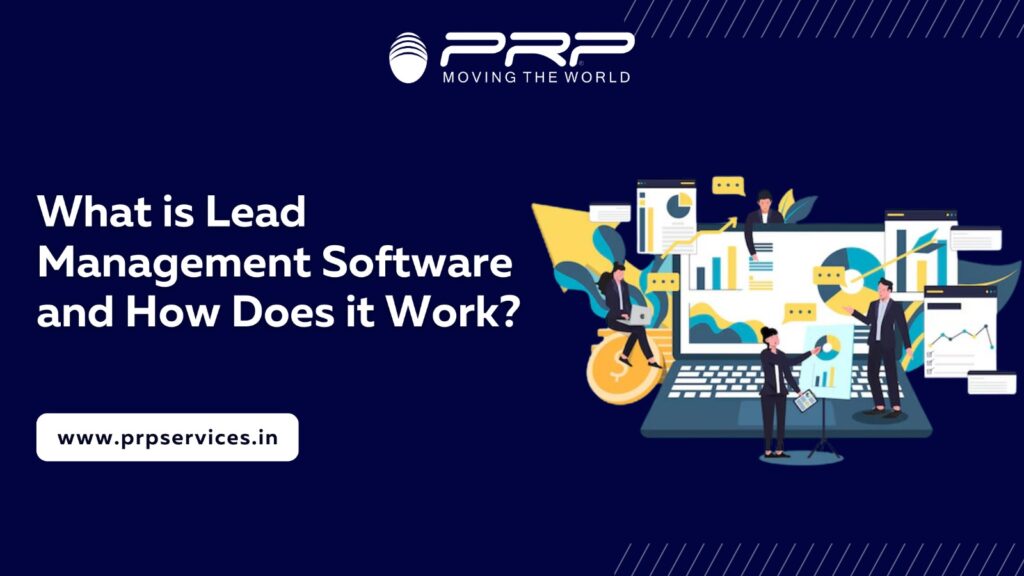In today’s competitive business landscape, generating leads is just the first hurdle. The true challenge lies in nurturing those leads and converting them into paying customers. That’s where lead management software comes in.
What is lead management Software?
Lead management software is a comprehensive tool utilized by businesses to streamline the process of acquiring, organizing, and nourishing potential customers or leads throughout their journey to conversion. This software centralizes lead capture from various sources like website forms, social media, and email campaigns, ensuring no opportunity slips through the cracks. It employs lead tracking and scoring mechanisms to prioritize leads based on their engagement level and likelihood to convert, allowing sales teams to focus their efforts effectively. Additionally, lead segmentation enables personalized communication tailored to specific demographics, behaviors, or interests.
The importance of lead management
In the dynamic landscape of modern business, staying ahead requires more than just traditional sales tactics. It demands a strategic approach to managing leads efficiently and effectively. This is where lead management software emerges as a game-changer, offering businesses a powerful tool to streamline their sales processes, learning relationships, and drive revenue growth.
- Centralized Lead Tracking: One of the primary advantages of lead management software is its ability to centralize lead tracking. Instead of scattered spreadsheets or disparate systems, businesses can consolidate all lead data into a single platform. This not only simplifies the process but also provides real-time visibility into the status of each lead, enabling sales teams to prioritize their efforts accordingly.
- Enhanced Lead Qualification: Not all leads are created equal. Lead management software empowers businesses to implement robust lead qualification criteria, ensuring that sales teams focus their energy on leads with the highest likelihood of conversion. By automating lead scoring based on predefined parameters such as demographics, behavior, and engagement level, organizations can optimize their sales efforts and improve conversion rates.
- Personalized Engagement: Personalized marketing and generic one-size-fits-all approaches are no longer Sufficient. Lead management software enables businesses to tailor their interactions with leads based on their unique preferences, interests, and pain points. By leveraging data insights and behavioral analytics, organizations can deliver targeted messaging and offers that Connect with each prospect, help strengthen relationships, and drive engagement.
- Streamlined Communication: Effective communication is the cornerstone of successful sales endeavors. Lead management software facilitates seamless communication between sales teams and leads through various channels, including email, phone, and social media. Automated workflows and reminders ensure timely follow-ups, preventing leads from slipping through the cracks and maximizing conversion opportunities.
- Data-Driven Decision-Making: Informed decision-making is vital for sustainable business growth. Lead management software equips organizations with actionable insights and analytics, enabling them to track key performance metrics, identify trends, and forecast future outcomes. By using data-driven intelligence, businesses can refine their strategies, optimize their processes, and stay ahead of the competition.
- Scalability and Flexibility: As businesses expand and shape, their requirements for lead management may change. Lead management software offers scalability and flexibility to accommodate growth, allowing organizations to customize workflows, add or modify fields, and integrate with other systems as needed. Whether catering to a small startup or a large enterprise, the adaptability of lead management software ensures seamless alignment with evolving business needs.
7 stages of the lead management Software Process

In the journey from prospect to customer, effective lead management plays a base role in guiding leads through various stages of the sales funnel. Understanding and mastering these stages are essential for businesses looking to optimize their conversion rates and drive sustainable growth. Let’s explore the seven stages of the lead management process:
- Lead Generation: The journey begins with lead generation, where businesses attract potential customers through various marketing channels such as social media, content marketing, email campaigns, and SEO. The goal is to capture the interest of prospects and force them to provide their contact information or engage with the brand in some way.
- Lead Capture: Once leads are generated, the next stage is lead capture, where businesses collect and store prospect information in a centralized database or CRM system. This typically involves capturing essential details such as name, email address, phone number, and any other relevant information that can aid in the lead qualification process.
- Lead Qualification: Not all leads are ready to make a purchase immediately. Lead qualification involves evaluating and scoring leads based on predefined criteria to determine their level of interest, intent to purchase, and fit with the company’s ideal customer profile. This stage helps prioritize leads and ensures that sales efforts are focused on those with the highest potential for conversion.
- Lead Nurturing: For leads that are not yet ready to buy, lead nutrition comes into play. This stage involves building relationships with prospects over time through targeted communication and personalized engagement. By delivering valuable content, addressing pain points, and staying top-of-mind, businesses can learn leads and move them closer to making a purchase decision.
- Sales Acceptance: Once a lead meets certain criteria and demonstrates a high level of readiness to buy, it is passed on to the sales team for further action. During the sales acceptance stage, sales representatives review the lead’s information, assess its quality, and decide whether to pursue it further or discard it. Clear communication and alignment between marketing and sales teams are essential to ensure a smooth handoff.
- Sales Engagement: With the lead now in the hands of the sales team, the focus shifts to sales engagement. This stage involves initiating direct contact with the prospect, understanding their specific needs and challenges, and guiding them through the sales process. Effective sales engagement requires active listening, effective communication, and the ability to address objections and concerns.
- Conversion and Follow-Up: The ultimate goal of the lead management process is to convert leads into paying customers. Once a sale is made, it’s crucial to follow up with customers to ensure satisfaction, address any post-purchase concerns, and help long-term relationships. This stage sets the foundation for customer retention, repeat business, and advocacy.
Best practices for lead management
Effective lead management is not just about acquiring leads it’s about nurturing relationships, optimizing processes, and ultimately driving conversions. By implementing best practices, businesses can maximize the efficiency of their lead management efforts and unlock their full growth potential.
Here are some key best practices to consider:
- Define Clear Lead Criteria: Start by establishing clear criteria for what constitutes a qualified lead. Consider factors such as demographics, firmographics, behavior, and engagement level. By defining these criteria upfront, you can ensure that your sales and marketing teams are aligned on which leads to prioritize.
- Implement Lead Scoring: Implement a lead scoring system to objectively assess the quality and readiness of leads. Assign points to different actions and behaviors, such as website visits, email opens, and content downloads. Leads with higher scores indicate a higher likelihood of conversion and should be prioritized accordingly.
- Automate Lead Routing: Use automation tools to route leads to the appropriate sales representatives based on predefined criteria such as geography, industry, or product interest. This ensures that leads are promptly followed up with by the right person, increasing the likelihood of conversion.
- Nurture Leads with Relevant Content: Develop a lead strategy that delivers relevant and valuable content to leads at each stage of the buyer’s journey. Use personalized email sequences, targeted ads, and educational resources to keep leads engaged and move them closer to making a purchase decision.
- Enable Seamless Communication: Foster seamless communication between sales and marketing teams to ensure a cohesive lead management process. Implement shared databases or CRM systems where both teams can access and update lead information in real-time. This transparency enhances collaboration and prevents leads from falling through the cracks.
- Track and Analyze Key Metrics: Regularly track and analyze key metrics related to lead generation, conversion rates, and sales velocity. Identify areas of improvement and adjust your strategies accordingly to optimize performance over time. data-driven insights, you can continuously refine your lead management processes for better results.
- Continuously Optimize and Iterate: Lead management is an ongoing process that requires continuous optimization and iteration. Regularly review your processes, experiment with new tactics, and ask for feedback from both your team and your leads. By staying feat and adaptive, you can stay ahead of the competition and drive sustained growth.
- Invest in Training and Development: Equip your sales and marketing teams with the necessary skills and knowledge to effectively manage leads. Provide training on lead management best practices, CRM systems, communication techniques, and customer relationship building. Investing in your team’s development ensures they have the tools and expertise to succeed in their roles.
How to choose a lead management software

Please don’t manage your leads by hand—let software support you. When choosing a lead management system, consider the following:
- Industry fit: While most lead management systems are pretty broad and can be used in any industry, some are more geared toward supporting B2C companies, while others are more B2B-focused. Plus, some industries (like finance and health care) have strict compliance requirements that may limit your options.
- Scalability: Does the system support all of your lead collection and categorization needs, even if your leads were to hit the thousands and tens of thousands? Some software comes with modular structures allowing you to add or remove certain functionalities to adapt to your business’s needs.
- User-friendliness: You want to strike a balance between customization and ease of use. The system you choose should be powerful and customizable enough to cater to your organization’s unique needs without confusing your staff.
- Cost: Have you assessed each system’s up-front and hidden costs? You may need to upgrade to a more expensive plan as your organization grows or pay extra for things like installation or data migration.
Automation for lead management
Lead management should be a self-sufficient machine. Here are some ways to save time on lead management and other marketing operations processes with the help of PRP Services Pvt Ltd:
- Automatically track your leads: Whether you acquire leads from forms, ads, email campaigns, or all of the above, you can set up automation so that lead information is automatically moved into your CRM or a spreadsheet, making it easier than ever to track your leads.
- Send personalized welcome messages: When a lead enters their information for the first time, there doesn’t need to be a sales team member on the other side of the screen welcoming them. Automatically send a welcome email or text message personalized to their role or interests. Marketing automation can help you do this.
- Automatically carry out nurture campaigns: Automation can also help you conduct lead nurture campaigns, automatically sending leads content such as discounts and event invitations throughout the buyer lifecycle.
- Lead management doesn’t have to be messy and tedious: Use PRP Services Pvt Ltd to automate your lead management process so that you have time to craft the perfect strategy for captivating your prospects.
Contact us Now for More Information

